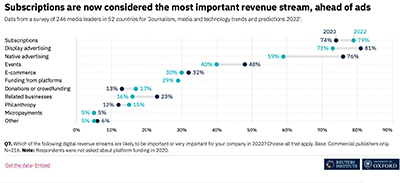 |
|||||||||||||||||||
|
|||||||||||||||||||
| The Cookieless Saga: Is It Time To Call In The Addressability Task Force? |
 |
| We are just two weeks into 2022 and some of our predictions for the year are already coming to fruition. As the latest deadline for a cookieless future is now maybe a year away - brands, publishers and agencies alike are getting their affairs in order around first-party data. Last week, Dentsu announced the hiring of Keith Camoosa in a brand new role as Chief Addressability Officer. In this role, Camoosa’s division will collaborate with Dentsu’s Merkle data unit, the M1 publisher addressable marketplace and the identity resolution platform Merkury to provide the agency with a “holistic view of identity and people-based marketing.” This announcement comes just weeks after PubMatic promotes Peter Barry from Regional Director, Australia and New Zealand & Head of Audience to a global role in NYC as VP of Addressability. |
| As we all become more uncomfortably comfortable with the demise of third-party cookies, the initial shock is turning into full-blown action for most. The collection of first-party data and even zero-party data is a top priority if not THE priority for this year as publishers attempt to rebuild trust and direct consumer relationships. However, when we talk about collecting the data and truly using it to its full advantage these are two completely separate ideas. While privacy is important, users are becoming more willing to give up minimal personal information in exchange for a single site visit. Deciphering exactly who these users are and who among them are worth investing in turning them into repeat visitors is a job within itself. But as more moolah is poured into data collection and dissemination, are companies also expanding their teams to tackle the additional workload that the third-party cookie deprecation will warrant? Hmm... First-party data will be key to maintaining and possibly exceeding CPMs and revenue ceilings but it cannot be at the expense of near or beyond capacity employees. As the great resignation is still in full swing, companies like Dentsu and PubMatic are realizing dedicated addressability leaders and teams are a must-have for long-term success. As first-party data becomes a new and/or renewed interest for most companies, these positions will stay intact long after third-party cookies go away. Since the true end date is still a moving target, building out an addressability team seems like it could be in everyone's best interest. |
| Agencies Turn to Supply to Create Competitive Edge | ||
| With the growing dominance of programmatic, media agencies – all of whom leverage the same buying platforms and have access to much of the same audiences, supply, and data sets – are struggling to set themselves apart in a crowded marketplace. To combat this trend, agencies are once again turning to publishers in an effort to gain preferential access to the inventory and audiences that can bring unique value to their brand partners. That’s why, according to recent research from IPSOS and IAS, we’re already seeing 93% of agency buyers implementing (or planning to implement in the next 12 months) some type of supply path optimization (SPO) initiative. |
||
| Publishers will be at the heart of programmatic’s future. Agencies looking to create real differentiation in the market and drive value for brands will be on the lookout for new ways to create transparency and efficiency in their media buying. They’ll be exploring everything from setting up their own supply marketplaces to enabling curation-based relationships with preferred publishers. And, with the demise of third-party cookies on the horizon, having first-party data sharing arrangements in place with preferred publisher partners, while securing preferential access to premium audiences and inventory, will become critical for agency buyers looking for a USP. Using next-generation SSPs like The MediaGrid, engineered by IPONWEB, publishers can work proactively with agencies to take control of their supply paths, driving SPO efficiency, differentiated supply strategies and proprietary marketplace initiatives with TAG Platinum-certified inventory enriched with unique data assets. Even better, The MediaGrid can do all this on a platform built with ad quality and transparency in mind. |
||
|
||
 |
| The Joy and Pain of CTV |
| All eyes are still on CTV. The steady growth in consumption was initially a response to the Pandemic but as more consumers cut the cable cord and streaming programming only expands, the younger sibling to linear TV has officially blossomed and is holding its own. The result? Advertising dollars are raining…no pouring down in its direction as it becomes one of digital advertising’s fastest-growing channels. So much so that the 2022 US CTV ad spending forecast jumped from $17.44 billion to $19.10 billion, according to Insider Intelligence and we have a feeling that estimate may increase as the year continues. As a result, brands will rely more heavily on programmatic CTV buys to reach cord-cutting audiences and all the major players will happily oblige after ending last year on such a high note. In 2021, The Trade Desk’s CTV revenue grew by 100% in Q3, Magnite also reported a 50% growth during this time and Xandr grew 180% in Q2. Although CTV shows no signs of slowing down, buyers will expect more of a return as it’s no longer enough to just have a presence for the sake of having one. |
| If you're working in media, the shift in CTV viewership is an exciting moment to be living in. But that excitement starts to fizzle as the many pain points bubble up to the surface. CTV still needs many solutions before investments in the channel really make sense. CTV's pain points are oozing. Fragmentation in the form of duplicated reach, ad fraud, and measurement remain at the forefront of buyer consideration. According to DoubleVerify, fraudulent CTV impressions dramatically increased in Q4 2021, and “18% of ‘CTV’ ads in unprotected programmatic inventory were fraud or invalid traffic. However, there is some promising activity around measurement options that can be expected this year. Lest we forget Nielsen's TV accreditation debacle, several alternatives are bringing exciting CTV options to the forefront this year including Nielsen itself. CTV will continue to succeed this year but with it comes expectations for much-needed improvements and strong solutions. |
| Are Clickable Ads The Future Of Podcasts? |

Photo by Ilias Chebbi on Unsplash
|
| Podcast listenership continues to climb at an insurmountable rate, positioning the channel as a new stable in media consumption. Podcast listeners represented 53.9% of monthly digital audio listeners in 2021, surpassing 50% for the first time. In a world where multitasking is glorified, podcasts provide a solution for consumers that most other mediums cannot — the ability to fully enjoy while checking off your to-do list. It’s no wonder then that Spotify just released a Call-to-Action card — a visual, clickable advertising format for podcasts. The card appears during the traditional ad read and also functions as an interstitial ad on the podcast and episode page as well as the now playing view. But here’s the kicker — this Call-to-Action card will live in those areas for seven days or until the campaign ends. This is just the latest move for Spotify to meet the growing demand for advertising positioning. |
| Let’s be honest. While consumers are falling harder for podcasts, the unavoidable flaw is the ad read. Remembering a URL you only hear is nearly impossible for a generation whose attention span is dwindling. Sometimes though, when that URL is coupled with a promo code, it will likely slip through the attention span cracks. Spotify’s new Call-to-Action card could be a perfect solution as the week-long placement allows listeners to learn more and/or perform the required action, at their convenience. With podcast ad spend expected to reach $1.74 billion this year and exceed $2 billion by 2023, Spotify is continuing to invest in many advancements within the podcast space. There’s no denying the instant attraction to a click-through placement in an all-audio setting but brands may be hesitant to immediately shift to this new format. The ad read may not be ideal but it’s what listeners are used to. They are engaged with and ultimately persuaded by the host's voice, which is the most attractive part of podcasts for brands. It will be interesting to see how the CTA card becomes a part of the media plan and its impact on advertiser KPIs. |
| Let’s Try Consent Again |
| We don’t want to get ahead of ourselves but 2022 could be off to a promising start for the publisher-consumer relationship. Initially, app tracking felt like a peeping tom causing consumers to quickly draw the blinds for more privacy. However, a recent finding from Gartner predicts the opt-out rate for mobile app tracking will decline from 85% now to 60% by 2023. |
| Simply put, ease is becoming a higher priority and people are realizing the benefit of going where everybody knows your…preferences. The pendulum of in-app targeted ads can swing from spot-on to how dare you at any given moment, but users are starting to understand it’s the price to pay for personalization. But that does not mean consumers are choosing to opt-in everywhere, they are still being selective and expecting to understand the value exchange when providing their personal data. Two main reasons some are choosing to flip the switch: brand familiarity and incentives like special offers, discounts, and/or reward programs. And of course, Apple is promising to ban incentives in exchange for tracking permissions through ATT (App Tracking Transparency), but brands are brainstorming clever ways to get around that. While familiarity and incentives are important, users are only becoming savvier when it comes to their data privacy. Above all, it’s important that pubs couple opt-in requests with clear info about why users should even share their information and how it's going to be used. Unfortunately, there isn’t a sole solution that publishers can apply to all audiences. When possible, a multi-tiered approach using contextual targeting, semi-anonymous traffic, and fully authenticated traffic can be the key to determining success. The publishers and advertisers who are creating meaningful connections with their audiences are those who are transparent from the beginning. What users aren’t responding to is trickery or dare we say a bad user experience. The best way to build consumer trust is to just ask for permission, make your intentions simple and offer the flexibility for users to change their minds whenever they want. |
| Content Fortress - A New Wave In Mobile Marketing |
| The saga around Apple’s App Tracking Transparency (ATT) has not lost steam as we enter the New Year. When this privacy update was first announced in 2020, it began a long-standing feud between Apple and Facebook. But any app publisher who heavily relied on third-party data for ad targeting will continue to take a beating from ATT, unless their Amazon of course. One major prediction to combat continuous loss this year is combining forces in the name of first-party data. Mobile Dev Memo is calling this alliance the Content Fortress, which includes any platform that services content interactions for third parties within its own first-party environment. |
| For those who may need a refresher on ATT after the holiday break, know of it but not by its official name and/or those who hoped this was a nightmare they’d wake up from in 2022, here’s a reminder - ATT is a new(ish) feature in iOS, iPADOS and tvOS 14.5 that requires apps to ask a user’s permission before tracking activity across other company apps and websites. Although app installs have seen an unimaginable uptick over the past two years, the ATT software update quickly cannibalized business for several platforms. Especially for those pubs already struggling with user experience and monetization issues due to brand unsafe ads (learn more in the latest AdMonsters Playbook: Balancing In-App Ad Quality With Revenue). Content Fortresses are being seen as a guaranteed win within this new mobile advertising ecosystem. Platforms that have the ability to complete third-party transactions within a first-party environment can use that purchase data for ad targeting and remain ATT compliant. Hence, the shift to e-commerce extensions for social media platforms like TikTok and Twitter. As mobile app pubs continue to navigate privacy booby traps while rebuilding their approach to first-party data, these kinds of partnerships are expected to continue well into 2022. |
 |
||||
|
||||
 |
||||
|
||||
 |
||||
|







